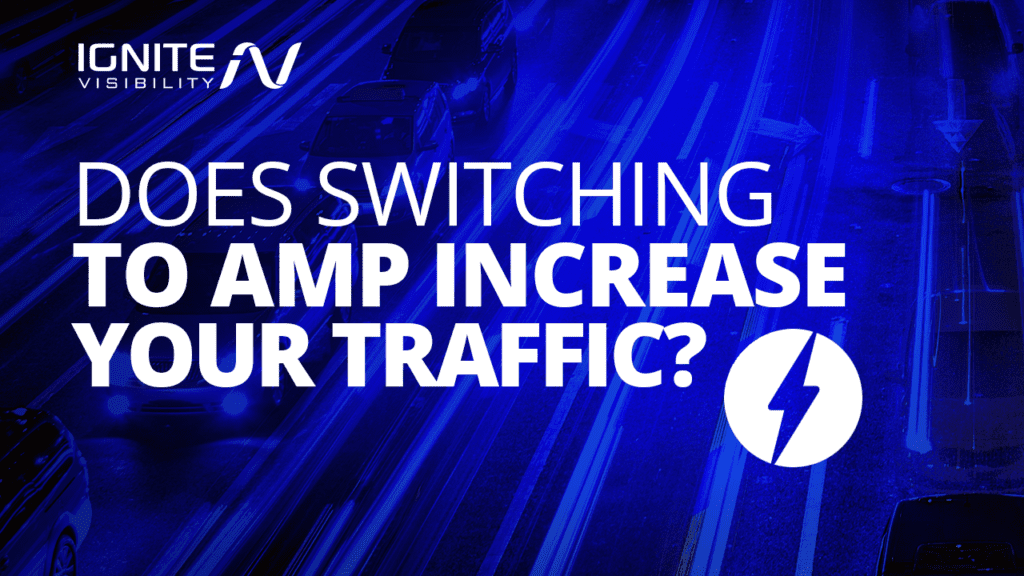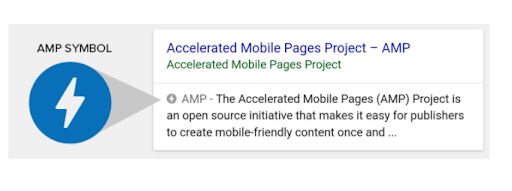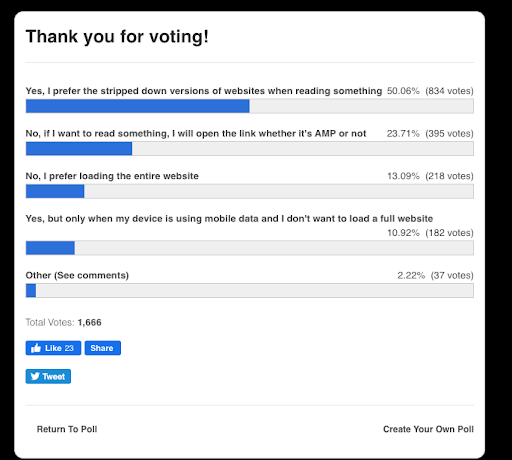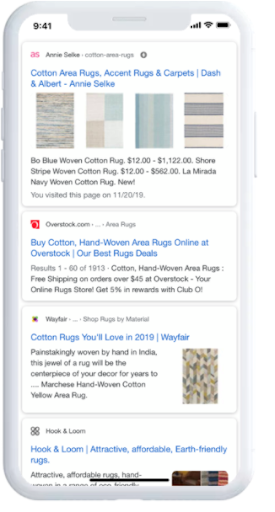Since launching in 2015, the AMP framework has sparked many debates.
AMP’s lightning-fast load times, mobile-friendliness, and enhanced visibility create better user experiences that, in theory, should boost web traffic.
I reviewed a few reports to find out whether switching to AMP increases traffic. Here’s a look at the findings.
What We’ll Cover:
- What’s AMP and how might it impact traffic?
- Does it affect engagement and rankings?
- AMP Testing Tool
- AMPs impact on publishers
- Determining if you should use AMP SEO
What is AMP and How Does it Impact Traffic?
AMP, or accelerated mobile pages, is a protocol that strips a page’s content to basic HTML and limits the use of JS and CSS to enable faster loading.
By using AMP, publishers can deliver mobile-optimized content that loads instantly, thus ensuring a better experience.
Initially, AMP gave media sites like the New York Times, CNN, or The Huffington Post, an easy way to make mobile sites faster and new opportunities for exposure via Google’s “Top Stories carousel.”
AMP pages are a requirement for eligibility to appear in Google’s Top Stories carousel on mobile, which increases exposure by placing stories at the top of the SERPs.
The logic here is, that visibility leads to clicks, while high-speed load times combined with great content builds trust and credibility.
Studies have shown that AMP can increase web traffic.
A 2017 Forrester Consulting Total Economic Impact study found that switching to AMP doubled on-page dwell times and provided a 10% bump in traffic. Wired.com saw a 25% increase in CTRs from the SERPs, while CTRs on ads increased by 63%.
An ongoing poll posted on 9to5Google.com asks visitors if they’d be more inclined to click an AMP link versus a non-AMP link when reading something.
Just over 50% said they prefer the “stripped-down version,” suggesting that consumers prefer this format over “regular” webpages.
The poll indicates that because users prefer AMP, that little blue lightning bolt may drive more traffic.
AMP’s Impact on Engagement, Rankings, & Conversions
A study commissioned by WompMobile and Precifient Direct looked at 26 websites and 9M+ AMP pages.
All pages were examined in an effort to see how pages performed as an aggregate to gauge the overall impact of AMP pages on domains.
Researchers calculated AMP performance based on a “Search Visibility” score that pulled data from Google Search Console (GSC) to measure overall impressions from all page rankings and keywords.
Additionally, researchers looked beyond basic click data to uncover two additional factors that might have an impact on a user’s likelihood to click.
- Presence of the lightning bolt icon next to a result, which could encourage users to click.
- Past positive experiences with AMP sites that might encourage users to choose that site for future visits.
The report looked at 26 websites and found that 77% of websites reviewed experienced improved organic search results on mobile.
Of those websites, the average gain was 27.1% in traffic, 15.3% higher click-through rates on SERP listings, and 33.8% increase in impressions on the SERP.
17 of the 26 domains that were reviewed saw an increase of 15% or more, though the average change across all websites was +47%.
Researchers also compared the results for e-commerce sites vs. publisher sites and noted a significant difference.
Aggregated results for 19 e-commerce sites:
- 32.1% increase in organic traffic
- 42.16% increase in SERP impressions
- 12.4% higher SERP click-through rates
Aggregated results for 7 publisher sites:
- 13.7% increase in organic traffic
- 11.1% increase in SERP impressions
- 23.1% higher SERP click-through rates
As you can see, e-commerce sites showed a greater improvement, on average, than websites focused on publishing content.
In another case study published by Moovweb, Annie Selke, an online home decor retailer, was able to outrank Amazon and Wayfair with AMP pages.
The brand saw a 32% increase in organic traffic and 13% more conversions.
Takeaways:
The report found that one in five sites did not see any improvement from implementing AMP, which researchers attributed to a few key things.
- Sites that already rank well are unlikely to see any notable boosts by embracing AMP.
- The flip side of this is, AMP can’t save a site on the decline. The report found that while AMP can give some websites a bump in traffic, it won’t do much if you’re experiencing a historical decline in traffic.
- Market conditions play a role, and if competitors are making changes around the same time, it could result in fewer traffic gains.
- Seasonality may also be a factor. The study only looked at 60 days of data, so it’s unclear how performance changes over time.
AMP Testing Tool
The AMP Testing Tool is provided by Google.
It makes sure your AMP pages and web stories are valid by Google.
This tool is simple to use, simply copy and paste your URL into the search bar and click “test URL.”
Google will find and crawl the page on your site and look for any errors.
AMP’s Impact on Publishers
Chartbeat and The Daily Beast collaborated on a two-part research study that sought to quantify the impact of AMP on publisher traffic.
According to Chartbeat, the main finding was that only one in three publisher sites saw an increase in organic traffic after they switched to AMP.
The first study was an A/B test run by The Daily Beast.
The website published half of their newly published articles in AMP and half in the standard format, choosing articles at random.
The test failed to provide clear evidence that AMP delivered more page views than the non-AMP content, though, during that time, The Daily Beast saw significantly lower revenue coming from AMP content.
In the second study, Chartbeat analyzed data from 159 publishers, including The Daily Beast and 158 Chartbeat clients that adopted the fast-loading format.
Chartbeat analyzed traffic months before the AMP implementation to get a baseline breakdown of what “normal” traffic looks like for each publisher to get a better sense of how AMP adoption impacted SERP traffic compared to other sources.
The report found that the average effect of AMP introduction was +22% (+-4%), but also noted that the results varied considerably between publishers.
Researchers then sought to identify common characteristics between publishers with the biggest increases but found no statistically significant correlation between AMP performance and factors like share of search traffic, type of content, or overall traffic to websites.
They noted that there’s a possibility that AMP implementation was executed to varying degrees of success, but mentioned that The Daily Beast followed the recommended guidelines and saw no change in traffic.
Takeaways:
According to the Chartbeat report, AMP could lead to traffic increases but those gains may come at the expense of monetization.
Though the format does offer faster page loads, only 34% of publishers reported seeing a notable increase in traffic.
The report also confirmed that AMP may have a negative impact on monetization, with many participants taking a hit to the bottom line.
The Daily Beast calculated that a traffic increase from AMP of 23% would be required to make up for the lost revenue but Chartbeat’s finding from that second study suggests that the format is unlikely to deliver gains on that scale.
The report found that only the top 11% of the pages analyzed were capable of hitting or exceeding that threshold.
Chartbeat recommends that publishers focus first on optimizing their AMP implementation process and other website issues instead of relying on the format to boost traffic.
For publishers, the main question about AMP should be less about how it changes traffic and more about how it changes revenue.
It’s worth noting that part of the issue is, AMP pages feature fewer ads than standard mobile pages, thus bringing in fewer ad dollars.
If your brand isn’t in a place to take a financial hit, I recommend focusing on improving page speed by optimizing for the new Core Web Vitals.
Who Should Use AMP?
- Who is your target audience? Do you work with B2B or B2C buyers? News media and e-commerce sites seem to be the most common AMP users, while most content targets a B2C crowd.
- How do people access your content? AMP makes the most sense for websites where the majority of users come from mobile devices.
- Is your website already mobile-optimized? If your site already loads quickly, AMP might not be necessary.
- Do you publish news updates/timely content? AMP is an effective tool for promoting time-sensitive content. If you primarily publish evergreen content, you’re better off focusing on SEO and other types of structured markup.
Wrapping up
AMP does offer some really powerful benefits including faster site speed and a better user experience on mobile.
Based on the findings, the reported benefits are only possible when publishers implement the AMP guidelines properly and already have a reputable site with high-quality content.
Still, AMP’s impact on traffic is hard to quantify.
For publishers, there was a lot of variation in performance. Much of this likely had to do with implementation issues, but quality and reputation likely played a role, here, too.
Ultimately, whether AMP drives traffic isn’t just about AMP. Content, branding, and relevance, are equally important. After all, page speed alone doesn’t create a great experience.



